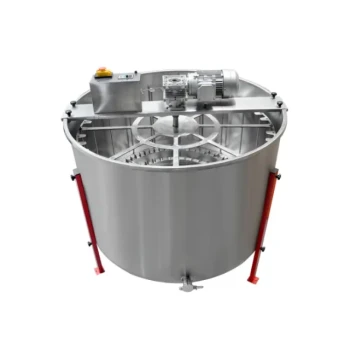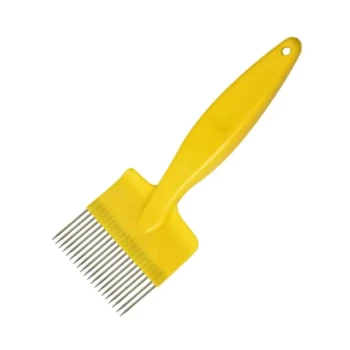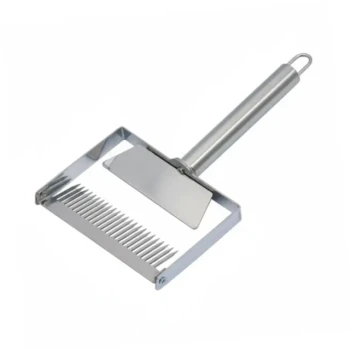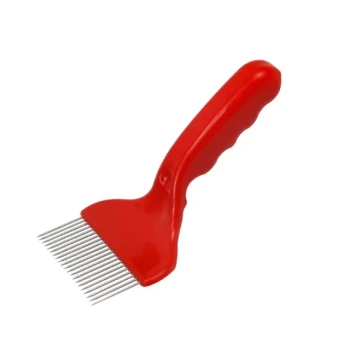As a general rule, the entire process of extracting honey from a single set of frames takes between 10 to 20 minutes. However, this is not a continuous spin time. The process must be broken into several shorter stages of increasing speed to prevent the weight of the honey from destroying the delicate wax comb.
The key to successful extraction is not adhering to a strict timetable, but rather understanding the process: start slow to lighten the load, increase speed gradually, and flip the frames if necessary. The goal is to preserve the comb for the bees to reuse.
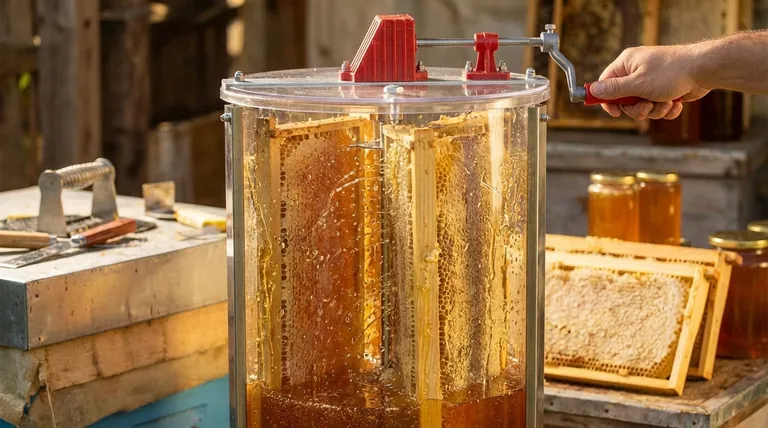
The True Goal: Preserving the Comb
Extracting honey is a balance of force and finesse. While your objective is to remove the honey, your higher priority should be to return undamaged comb to the hive. This saves the bees an immense amount of energy and resources, leading to a healthier and more productive colony.
Why You Can't Just Spin at Full Speed
At the start of extraction, a frame is heavy with honey. If you immediately apply high rotational speed, the centrifugal force will push the honey on the outer side against the central foundation. The sheer weight can "blow out" the comb, breaking the wax structure and making the frame unusable.
The Critical Role of Honey Temperature
The single most important variable is honey temperature. Warm honey is significantly less viscous and flows easily. Cold honey is thick like peanut butter, requiring more force and time to extract, which dramatically increases the risk of a blowout.
Ideally, your honey frames should be in a room at 85-95°F (30-35°C) for at least 24 hours before you begin. This makes the entire process faster, easier, and safer for your comb.
The Step-by-Step Extraction Process
The exact procedure depends on your extractor type. Most small-scale beekeepers use a tangential extractor, which requires flipping the frames.
For Tangential Extractors (Frames Face Sideways)
This common hobbyist extractor holds frames like spokes on a wheel, with one side of the comb facing outward. This necessitates a three-step process to avoid damage.
-
First Spin (Low Speed): Begin by spinning slowly, just fast enough to see honey begin to hit the walls of the extractor. The goal here is to remove about 40% of the honey from the first side. This lightens the frame enough to prevent a blowout in the next step. This typically takes 2-4 minutes.
-
Second Spin (Medium to High Speed): Stop the extractor, flip each frame so the opposite, un-extracted side now faces out. Because the first side is now partially empty, you can spin much faster to extract 100% of the honey from this second side. This is the longest spin, often taking 5-8 minutes.
-
Third Spin (High Speed): Stop the extractor again and flip the frames back to their original orientation. With all the honey gone from the other side, you can now spin at full speed to safely remove the remaining 60% of the honey from the first side. This final spin takes another 3-5 minutes.
For Radial Extractors (Frames Face Outward)
Larger and more efficient radial extractors position the frames with the top bar facing the outer wall. Centrifugal force pulls honey from both sides of the comb simultaneously.
With a radial extractor, no flipping is required. However, you still must ramp up the speed gradually. Start slow for a few minutes to lighten the overall load before increasing to full speed for the remainder of the time, which is typically a total of 10-15 minutes.
Understanding the Key Variables
No two extractions are identical. You must adjust your technique based on the conditions.
Honey Viscosity is Everything
As mentioned, warm honey is key. If you try to extract cold, thick honey, you will need longer spin times and run a much higher risk of comb damage, even if you follow the correct process.
Comb Strength: New vs. Old
Newly drawn comb built on new foundation is white and exceptionally fragile. It must be spun with extreme care and at lower speeds. Older comb that has been used for brood is darker, stronger, and more resilient, able to withstand higher forces.
Judging "Done"
Don't rely only on a timer. The best indicators are sound and sight. When you first start, you will hear and see a strong spray of honey hitting the extractor walls. As the frames empty, this spray will reduce to a fine mist and then stop. The change in the sound is your primary cue that a side is finished.
Making the Right Choice for Your Harvest
Use these principles to guide your actions during the extraction process.
- If your primary focus is protecting new, fragile comb: Use very low starting speeds and add an extra, intermediate spin step if necessary to lighten the load even more gradually.
- If your primary focus is speed with a motorized extractor: Rely on a gradual, programmed ramp-up of speed. Let the machine do the work of slowly increasing the G-force.
- If your honey is cool and you cannot warm it: Be prepared for significantly longer spin times and accept that you may not be able to extract every last drop without risking comb damage.
Ultimately, the right duration is determined not by a clock, but by observing the honey and listening to your equipment to protect your comb.
Summary Table:
| Variable | Impact on Spin Time | Key Consideration |
|---|---|---|
| Extractor Type | Tangential: 10-20 min (with flipping). Radial: 10-15 min (no flipping). | Tangential requires a multi-step process to protect the comb. |
| Honey Temperature | Warm honey (85-95°F): Faster extraction. Cold honey: Much slower, higher risk. | Properly warming frames is the most critical step for efficiency. |
| Comb Strength | New, fragile comb: Requires slower speeds. Old, strong comb: Can handle higher speeds. | Adjust your technique based on the comb's age and condition. |
Streamline Your Honey Harvest with HONESTBEE
Perfecting your extraction process is key to a healthy, productive apiary. At HONESTBEE, we supply commercial apiaries and equipment distributors with the durable, high-performance extractors and supplies needed for efficient, large-scale operations.
We help you:
- Maximize Efficiency: Reduce extraction time and labor with our reliable radial and tangential extractors.
- Protect Your Investment: Our equipment is designed to handle delicate comb with care, preserving it for reuse.
- Scale Your Operation: Access wholesale-focused pricing on everything from uncapping knives to storage tanks.
Ready to upgrade your harvest? Let's discuss how our solutions can benefit your business.
Contact HONESTBEE today for wholesale pricing and expert support!
Visual Guide
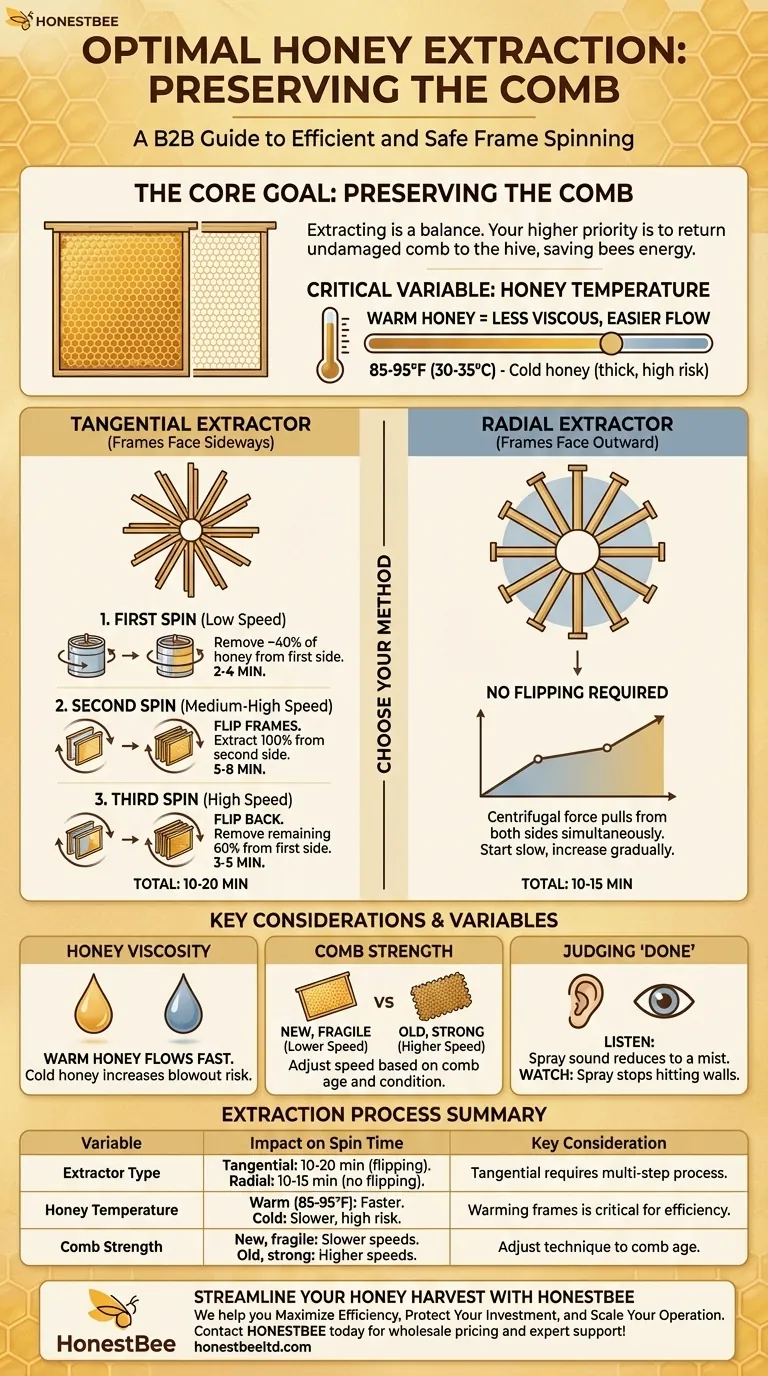
Related Products
- HONESTBEE 3-Frame Manual Acrylic Honey Extractor
- HONESTBEE 72 Frame Industrial Electric Honey Extractor for Beekeeping
- HONESTBEE 6 Frame Three Use Electric Honey Extractor for Beekeeping
- 8-Frame Electric Self-Reversing Honey Extractor Spinner for Commercial Honey Extraction Equipment
- 2 Frame Stainless Steel Manual Honey Spinner Extractor for Beekeeping
People Also Ask
- How often do beekeepers collect honey? Maximize Your Hive's Sustainable Yield
- How do you manually extract honey? Choose the Best Method for Your Hive
- How do you collect honey at home? A Beginner's Guide to Harvesting from Your Hive
- What equipment is used for honey harvest? Essential Tools for Every Beekeeper
- What is a fun and easy alternative to using a honey extractor for harvesting honey? Try the Crush and Strain Method






